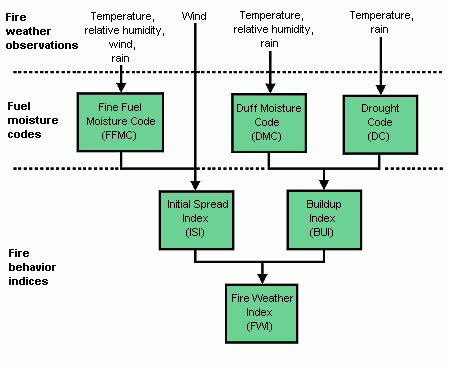Background Information
Canadian Forest Fire Weather Index (FWI) System
Summary
The Canadian Forest Fire Weather Index (FWI) System consists of six components that account for the effects of fuel moisture and weather conditions on fire behavior.
The first three components are fuel moisture codes, which are numeric ratings of the moisture content of the forest floor and other dead organic matter. Their values rise as the moisture content decreases. There is one fuel moisture code for each of three layers of fuel: litter and other fine fuels; loosely compacted organic layers of moderate depth; and deep, compact organic layers.
The remaining three components are fire behavior indices, which represent the rate of fire spread, the fuel available for combustion, and the frontal fire intensity; these three values rise as the fire danger increases
Structure of the FWI System
The diagram below illustrates the components of the FWI System. Calculation of the components is based on consecutive daily observations of temperature, relative humidity, wind speed, and 24-hour precipitation. The six standard components provide numeric ratings of relative potential for wildland fire.

Fine Fuel Moisture Code
The Fine Fuel Moisture Code (FFMC) is a numeric rating of the moisture content of litter and other cured fine fuels. This code is an indicator of the relative ease of ignition and the flammability of fine fuel.
Duff Moisture Code
The Duff Moisture Code (DMC) is a numeric rating of the average moisture content of loosely compacted organic layers of moderate depth. This code gives an indication of fuel consumption in moderate duff layers and medium-size woody material.
Drought Code
The Drought Code (DC) is a numeric rating of the average moisture content of deep, compact organic layers. This code is a useful indicator of seasonal drought effects on forest fuels and the amount of smoldering in deep duff layers and large logs.
Initial Spread Index
The Initial Spread Index (ISI) is a numeric rating of the expected rate of fire spread. It is based on wind speed and FFMC. Like the rest of the FWI system components, ISI does not take fuel type into account. Actual spread rates vary between fuel types at the same ISI.
Buildup Index
The Buildup Index (BUI) is a numeric rating of the total amount of fuel available for combustion. It is based on the DMC and the DC. The BUI is generally less than twice the DMC value, and moisture in the DMC layer is expected to help prevent burning in material deeper down in the available fuel.
Fire Weather Index
The Fire Weather Index (FWI) is a numeric rating of fire intensity. It is based on the ISI and the BUI, and is used as a general index of fire danger throughout the forested areas of Canada.
Daily Severity Rating
The Daily Severity Rating (DSR), an additional component of the FWI system, is a numeric rating of the difficulty of controlling fires. It is based on the Fire Weather Index but it more accurately reflects the expected effort required for fire suppression.